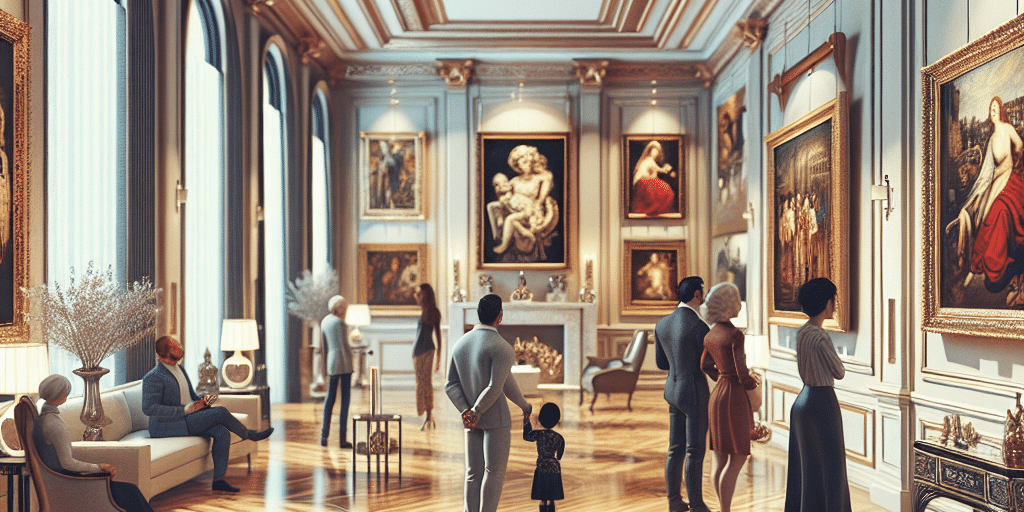<h1>Masterpieces at Home: The Art of Curating a Private Collection for Affluent Families</h1>
<p>Art has long been a statement of wealth, culture, and personal identity. For affluent families, curating a private art collection is not merely an investment but an expression of their values and aesthetics. A well-crafted collection transforms a house into a home, showcasing not only exquisite pieces but also the story of the collectors.</p>
<h2>Understanding Personal Aesthetic</h2>
<p>The first step in curating a private collection is understanding the personal aesthetic of the family. Engaging with the preferences of each family member is crucial. Considerations may include:</p>
<ul>
<li>Styles: Modern, contemporary, classical, or abstract?</li>
<li>Mediums: Paintings, sculptures, photographs, or mixed media?</li>
<li>Themes: Nature, historical events, personal stories, or community?</li>
</ul>
<h2>Setting a Budget and Timeline</h2>
<p>Establishing a budget is essential when developing a meaningful collection. This budget should encompass not only the purchase prices but also additional costs such as:</p>
<ul>
<li>Framing and display</li>
<li>Insurance and maintenance</li>
<li>Art consultants or advisors</li>
</ul>
<p>Additionally, creating a timeline for collecting can help in systematically building the collection over time while ensuring that each acquisition is carefully considered.</p>
<h2>Building Relationships with Artists and Galleries</h2>
<p>Connecting with artists, galleries, and art dealers can enhance the collection-building experience. Establishing these relationships can provide insights into the artwork’s background, provenance, and market value. Many collectors find great value in engaging with:</p>
<ul>
<li>Emerging artists to discover unique pieces</li>
<li>Local galleries that align with their aesthetic</li>
<li>Art fairs and exhibitions to explore new trends</li>
</ul>
<h2>Creating a Display Strategy</h2>
<p>The way art is displayed can significantly influence its impact. Considerations for an effective display might include:</p>
<ul>
<li>Lighting: Proper illumination enhances colors and textures.</li>
<li>Placement: Strategic positioning of artworks can create visual flow.</li>
<li>Rotation: Regularly changing displays keeps the collection dynamic and engaging.</li>
</ul>
<h2>Documenting and Maintaining the Collection</h2>
<p>Documentation is essential for tracking provenance, valuation, and condition over time. Families should maintain:</p>
<ul>
<li>Detailed records for each piece, including purchase details and artist information</li>
<li>Regular evaluations to assess insurance values</li>
<li>A condition report for ongoing maintenance</li>
</ul>
<h2>Conclusion</h2>
<p>Curating a private art collection is an enriching journey that reflects personal tastes, family heritage, and aesthetic aspirations. For affluent families, it's an opportunity to engage with culture, express individuality, and create a legacy that transcends generations. With careful curation, every piece can tell a story, transforming a house into a true masterpiece at home.</p>
<footer>
<p>© 2023 Art Newtworks - All Rights Reserved.</p>
</footer>- Home
- About Family Office HQ
 About our projectKnow more about Family Office HQ
About our projectKnow more about Family Office HQ Worldwilde NetworkBecause diversity lorem ipsum dolor porta ullam rutrum glavrida lorem unicus amet.
Worldwilde NetworkBecause diversity lorem ipsum dolor porta ullam rutrum glavrida lorem unicus amet. The NetworkGlavrida ipsum nulla – dolor lorem amet ipsum dolor porta ullam rutrum glavrida unicus.
The NetworkGlavrida ipsum nulla – dolor lorem amet ipsum dolor porta ullam rutrum glavrida unicus. How It WorksTo Know how It works and to create new connection on the network
How It WorksTo Know how It works and to create new connection on the network
- Our E-Book
- News
- The Network
- Contact
Masterpieces at Home: The Art of Curating a Private Collection for Affluent Families
You are here:
- Home
- Lifestyle and Networking
- High-net-worth lifestyle
- Masterpieces at Home: The Art…










